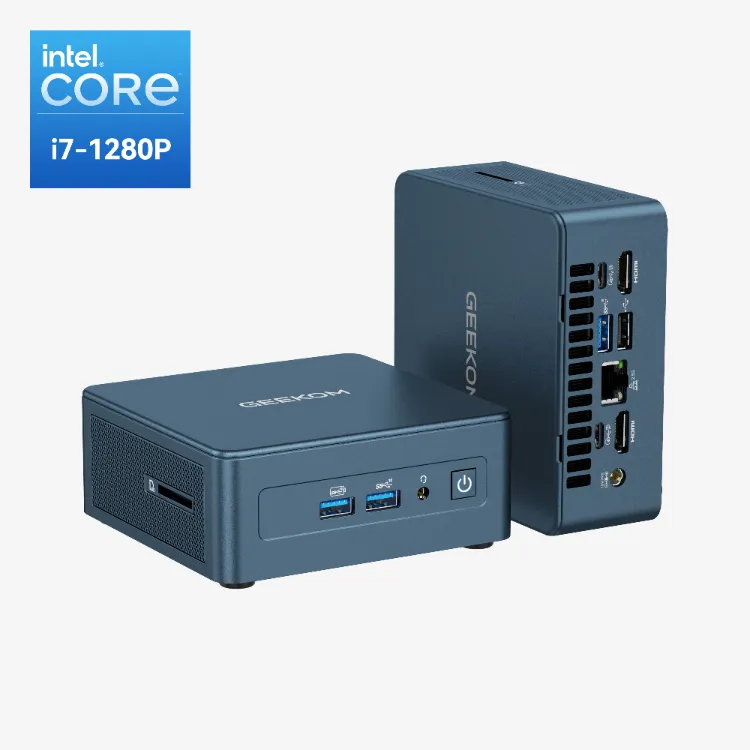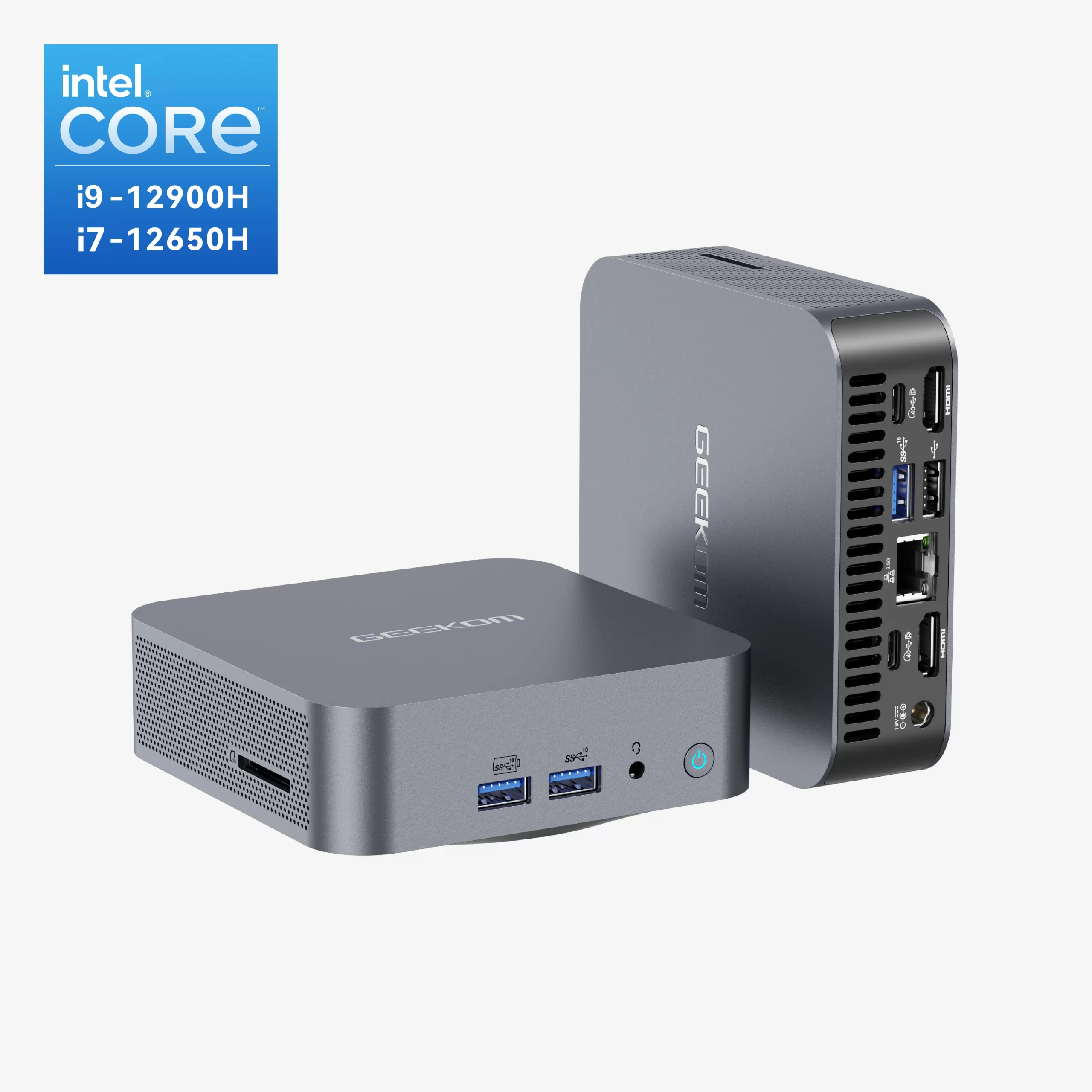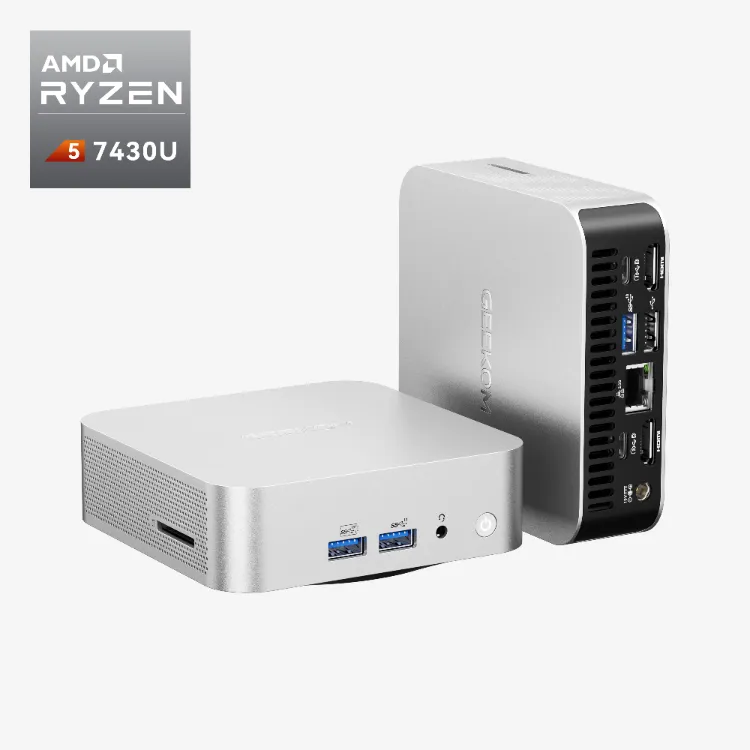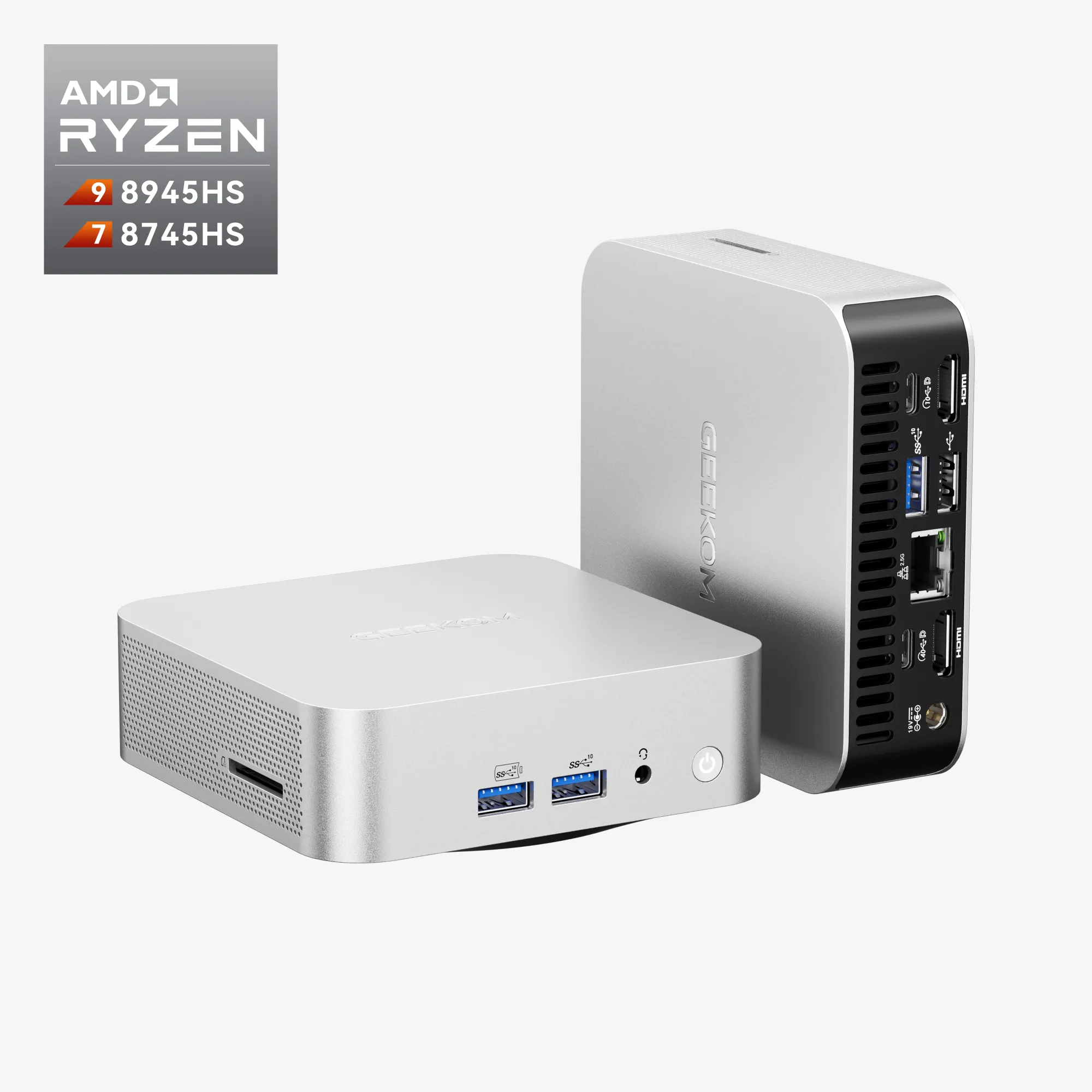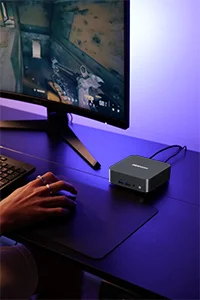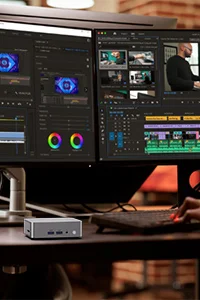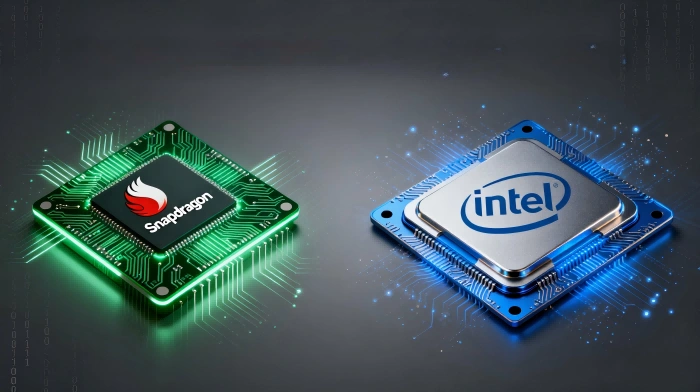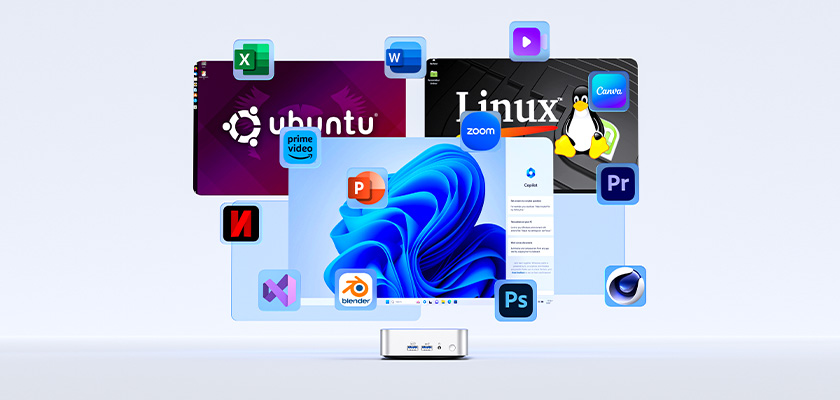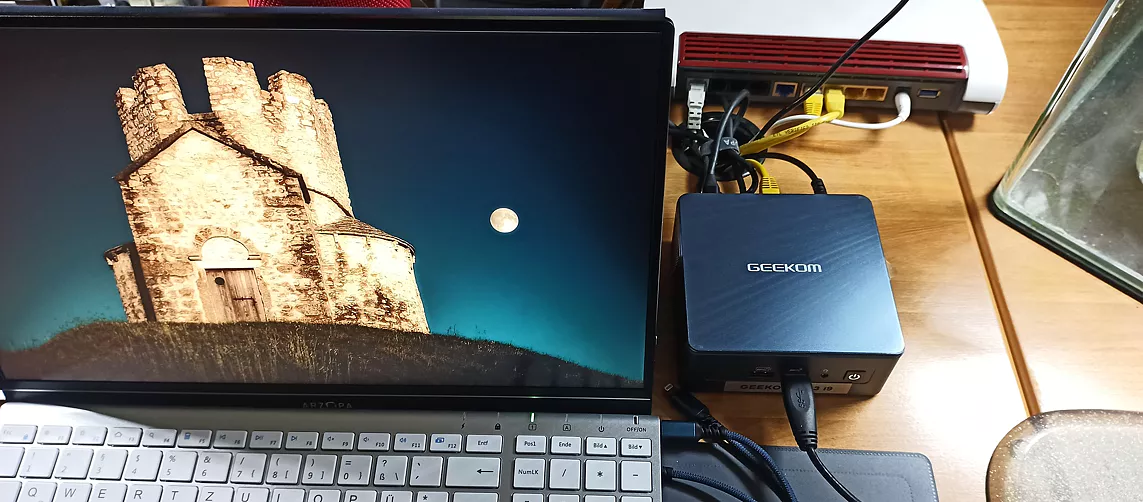The world of processors is going through a huge change right now. It has been years since anyone could challenge Intel as the leader. Most laptops and desktops use its x86 architecture. But a new player from the world of mobile phones has come along and is threatening to change the rules. As of now, Qualcomm’s Snapdragon processors, which are based on the ARM architecture, are not only for phones. They are now powering a whole new generation of laptops and desktops that promise to have long battery lives and continuous internet access. This guide will help you understand the main differences between these two fast processors and what that means for the next computer you buy.
Learning About Processor Architectures
Before you can really understand the Snapdragon vs. Intel argument, you need to know that the two are built on very different foundations. A diesel engine and a gasoline engine are both used to power cars, but they do it in very different ways.
What is Snapdragon?
Qualcomm makes Snapdragon processors. For years, Qualcomm has been the leader in the cell phone market. ARM architecture, which puts “mobile first” design principles at the heart of its chips. In other words, they are built from the ground up to use very little power. Think about it: you need your phone to last all day on a single charge.
ARM’s RISC (Reduced Instruction Set Computing) design does a great job of that. It follows easier steps to complete tasks, so it does not use a lot of power all at once. This focus on efficiency is now making its way into laptops, which promise battery life of up to two days and instant-on features, just like your phone.
What is Intel?
Intel, on the other hand, has been making processors for a long time. Their chips are based on the x86 architecture, which has been around for a very long time. Intel has been the best choice for desktops and laptops for a long time, and for good reason. People know their processors for how powerful and well they work. The x86 architecture is based on CISC, which means that it can handle more complicated tasks with just one instruction.
In the past, this has given them an advantage in demanding tasks like gaming and video editing. But this power comes with a price: it uses more power. They have made a lot of progress in making their chips more efficient, but they still can not match the battery life of their ARM-based competitors.
Snapdragon vs Intel: Performance Comparison
This is where the road meets the rubber. In the real world, how do these two different ways of designing processors compare? Let us break it down.
CPU Performance Benchmarks
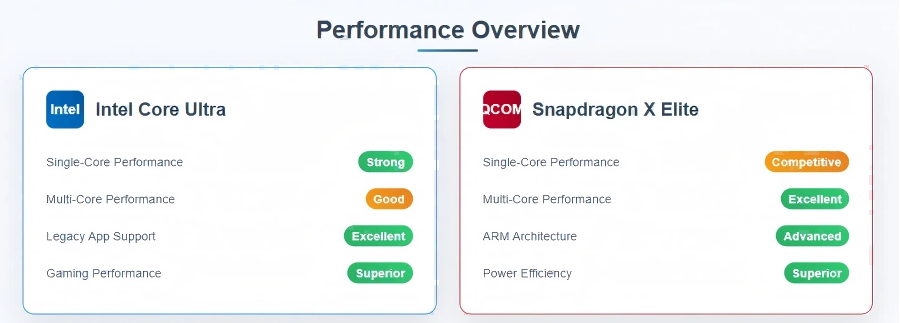
The lines are becoming less clear when it comes to raw CPU power. Intel was far ahead for a long time in both single-core and multi-core performance. For tasks that need a single fast processor core, like many older games and apps, single-core performance is important. Modern programs that can split their work between multiple cores, like video editing and 3D rendering, need to have great multi-core performance.
Detailed Performance Comparison
Based on recent benchmarks from reliable sources like PC Mag
| Performance Category | Intel Core Ultra | Qualcomm Snapdragon X Elite | Market Trend |
|---|---|---|---|
| Single-Core Performance | ✓ Traditionally dominant Best for older games & apps | ○ Catching up Competitive but not leading | Stable Lead |
| Multi-Core Performance | ○ Previously leading Good for modern workloads | ✓ Now outperforming Excellent for video editing & 3D rendering | ARM Rising |
| Architecture Advantage | ✓ x86 compatibility Mature ecosystem | ✓ ARM efficiency Modern design benefits | Competition |
| Use Case Suitability | ✓ Legacy applications Gaming workloads | ✓ Content creation Multi-threaded tasks | Diversifying |
| Market Position | Established leader facing competition | Rising challenger with breakthrough performance | Shift in Power |
As of late, though, tests from reliable sources like PC Mag have shown that Qualcomm’s new Snapdragon X Elite processors are not only catching up, but in some cases doing better in multi-core performance than Intel’s newest Core Ultra chips. This is very important because it means ARM-based processors can now compete with Intel’s most powerful chips.
Graphics Performance (GPU)
Integrated graphics have come a long way, and many tasks no longer need an extra, pricey graphics card. As standard, both Intel and Snapdragon processors have GPUs built in. Intel’s newest laptops have their new Arc graphics, which are a big step up from their old Iris Xe graphics.
While Intel’s Arc graphics do better in some tests, the Adreno GPU built into the Snapdragon X Elite does better overall. When you think about how much less power the Snapdragon is using, this is even more impressive. It is surprising how well the newest Snapdragon processors work for light video editing and casual gaming.
AI and Machine Learning Performance
Artificial intelligence is the next big thing in computing, and both Intel and Qualcomm are putting a lot of money into it. Recently made processors have Neural Processing Units (NPUs) that are just for AI and machine learning tasks. This is important for advanced photo and video editing tools as well as real-time language translation tools.
ARM, the company that makes Snapdragon’s architecture, has made a lot of progress in this area. Their newest designs promise much faster AI inference times. This means that apps that use AI will run faster and more efficiently on Snapdragon-powered devices. Snapdragon’s history of putting phones first could give it a long-term edge in this important area.
Software Compatibility Analysis
What you do is only half of the story. It does not matter if you have the best processor in the world if it can not run the software you need. This is where the fight between Intel and Snapdragon gets really interesting.
Operating System Support
Software that does not work with ARM-based laptops has been a problem for years. Most Windows apps were made for Intel’s x86 architecture, so to run them on ARM-based devices, they had to be run through an emulator, which was often slow and buggy. But with Windows 11, Microsoft has put in a lot of work to make things better on ARM.
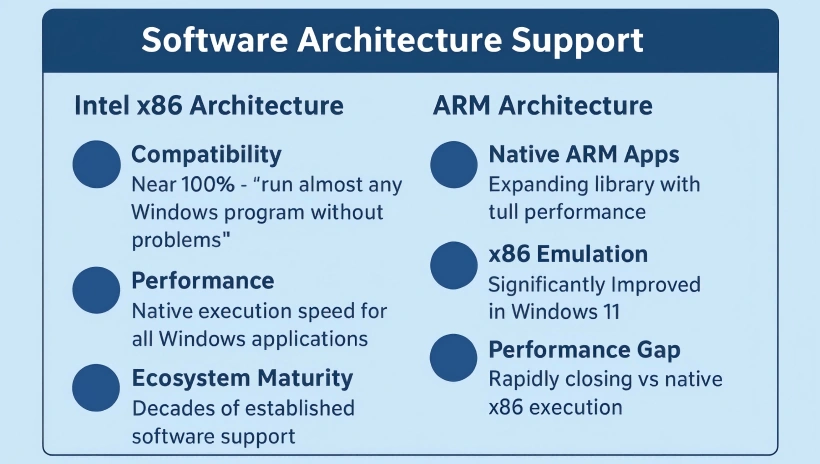
The newest versions of Windows 11 on ARM come with a much better emulator that can run most x86 programs surprisingly quickly and reliably. Even better, more and more developers are now compiling their apps to run natively on ARM. This means they run at full speed without having to be emulated. The GEEKOM QS1, which will be the world’s first mini PC with a Snapdragon X Elite processor, is a sign of how this ecosystem is growing. Windows 11 Pro for ARM will already be on it so that it can run a new generation of native ARM apps.
Intel-based PCs still have the upper hand when it comes to Windows, though. An Intel-powered computer like the GEEKOM IT13 will run almost any Windows program without any problems. The gap is getting smaller, though, and software compatibility worries that many users had before are quickly going away.
Android Optimisation and Chrome OS Performance
This is one area where Snapdragon really shines. For years, Snapdragon processors have been powering Android phones, so they are perfectly suited to running Android apps. This is a big deal for Chrome OS, which can use Google Play Store apps for Android.
A Snapdragon-powered Chromebook is a great choice if you want a device that can run all of your favourite mobile apps without any problems. Intel has been working to make its processors better at running Android apps, but it still can not beat Snapdragon’s native advantage.
Price and Value Comparison
When you buy a PC, your budget is very important, and the prices of Snapdragon and Intel processors are always changing. In the past, Intel has had a lot of different processors, from the cheap Celeron and Pentium chips to the very expensive Core i9 processors. This has made it simple to get an Intel-powered PC at almost any cost.
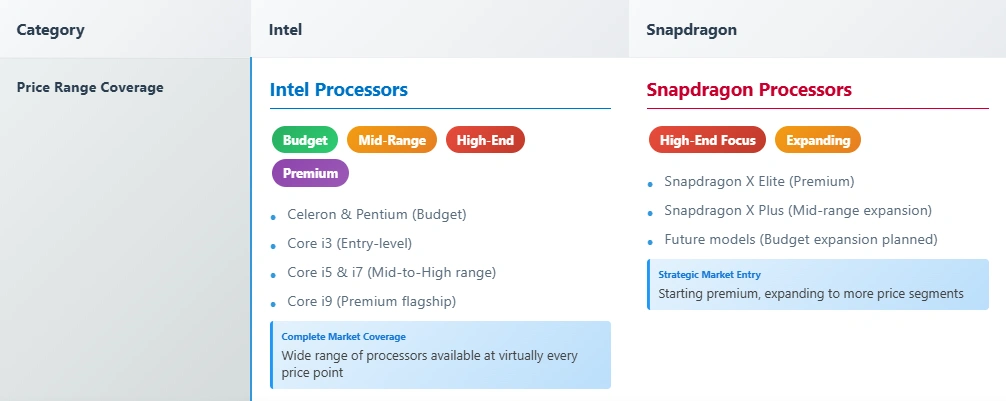
Snapdragon, on the other hand, has always been more interested in the high-end of the mobile market. With their move into laptops, though, they are beginning to offer more choices. Intel’s mid-range Core i5 and Core i7 processors are competing with the new Snapdragon X Plus, which offers a great mix of performance and efficiency at a lower price. High-end chipsets like the Core i9-13900HK in the powerful GEEKOM IT13 mini PC 2025 Edition will be up against the Snapdragon X Elite. Once the first Snapdragon X Elite devices come out, they will likely be very expensive. However, as the X Plus and other models come out, ARM-based Windows laptops should become more affordable.
| Budget-Friendly Options | Intel Advantage Market Leader -Established low-cost device ecosystem -Celeron and Pentium for ultra-budget builds -Proven track record of reliability -Wide OEM support for budget devices -Budget ChampionStill the easier choice for buyers on a budget with extensive low-cost options | Snapdragon Position Limited Currently -Currently focused on premium segment -X Plus targeting mid-range expansion -Future budget options in development -Growing Windows on ARM ecosystem |
| Mid-Range Competition | Intel Core i5/i7 Strong Competition -Core i5 processors (mainstream performance) -Core i7 processors (performance enthusiasts) -Established market presence | Snapdragon X Plus Strong Value -Great performance and efficiency mix -Competitive pricing vs Intel i5/i7 Superior power efficiency -Modern ARM architecture benefits -Efficiency LeaderExcellent balance of performance and efficiency at competitive mid-range pricing |
| High-End/Premium | Intel Flagship Established Leader -Core i9-13900HK and similar flagships -Maximum raw performance Gaming and workstation focus | Snapdragon X Elite Premium Entry Direct competition with Core i9 Expected premium pricing initially Superior power efficiency at high performance Mobile-first premium experience |
Intel is still often the easier choice for buyers on a budget, as it has a track record of reliability and a wide range of low-cost devices. As the Windows on ARM ecosystem grows, however, you can expect Snapdragon and its partners to offer more competitive prices, making their products a great value, especially when you consider the possibility of better battery life and connectivity.
Gaming Performance: Snapdragon vs Intel
You needed a separate graphics card for a long time if you wanted to play games on your laptop. The built-in graphics just were not good enough. That is starting to change, though, as both Intel and Snapdragon make big improvements to how well their built-in graphics work. Can you really play games on these new processors?
Integrated Graphics Gaming
To be clear, you will not be able to play the newest AAA games in 4K with all the settings turned up to eleven on your built-in graphics card. But you might be pleasantly surprised by how well it works with casual games and even some popular e-sports games. PC Mag’s tests showed that the Snapdragon X Elite can handle demanding games like Control and Shadow of the Tomb Raider at 1200p with low settings, with frame rates that are manageable [1]. This is a big deal for an integrated GPU, and it means that the Snapdragon X Elite is on par with, or even better than, Intel’s own integrated Arc graphics.
| Performance Category | Intel Arc Graphics | Qualcomm Adreno GPU | Winner |
|---|---|---|---|
| Casual Gaming | Intel Arc Graphics Good -Solid 1080p gaming experience -Better compatibility with older games -x86 optimization advantages | Adreno GPU Surprisingly Good WINNER -Excellent performance for light gaming -Smooth gameplay with better efficiency -ARM-optimized gaming experience | Adreno |
If you want to play games on a Snapdragon device, you will need to go through an emulator because most games are still made for x86 processors. Even though this representation has improved a lot, it can still slow things down. When more game developers make games that run natively on ARM, you can expect Snapdragon devices to run games even faster.
External GPU Compatibility
An external GPU (eGPU) is a great choice if you want to play games seriously. You can connect an eGPU to your laptop through a fast port like Thunderbolt. It is a separate graphics card. You can use this as a thin and light laptop when you are on the go and as a powerful gaming PC when you are at home. Intel has the upper hand in this area right now. A lot of mini PCs that are based on Intel, like the GEEKOM IT13, have Thunderbolt ports that make it easy to connect an eGPU. This lets you turn a small, quiet mini PC into a real gaming powerhouse.
The Snapdragon X Elite platform works with up-to-date connectivity standards like USB4, which could allow eGPUs to work. However, the ecosystem is still very new. Plug-and-play eGPU support for Windows is not as good on ARM devices yet as it is on Intel devices. Because of its history and dependability, an Intel-based system is still the better choice for serious gamers who want the freedom of an eGPU.
Professional Workloads Comparison
Many of you use your computers for more than just everyday tasks and games. You also use them for hard professional work. Processing speed is very important whether you are a content creator, programmer, or data scientist. How well do Snapdragon and Intel do at getting real work done?
Content Creation
You know that time is money if you edit videos, take pictures, or make 3D art. You have more time to be creative at work when you can render a video or process a bunch of photos faster. Many years ago, Intel was the best choice for content creators because its processors were very fast and most creative software was designed to work well with the x86 architecture.

With its 14-core Intel Core i9 processor, the GEEKOM IT13 is a powerful Intel-based computer that can quickly edit videos and render 3D models. But the new Snapdragon X Elite is ready to compete with Intel’s top spot. With 12 high-performance cores, the Snapdragon X Elite has the multi-core power to handle these heavy tasks. Also, the built-in NPU can speed up AI-powered features in creative apps by a lot, such as AI-powered object tracking in videos or AI-powered noise reduction in photos.
The biggest problem for Snapdragon is still making the software work better. Adobe and other big names have started putting out native ARM versions of their creative apps, but the ecosystem is not as developed as it is for Intel yet. For now, an Intel-based system is still the safer choice for professionals who need to be sure that their system will work with a lot of different plugins and specialised software.
Programming and Development
For programmers, a powerful processor means that compilation times are shorter and development goes more smoothly. More proof that the new Snapdragon processors’ multi-core performance could make a big difference in this area. As a result, the Snapdragon X Elite’s 12 cores should, in theory, provide excellent performance when compiling large codebases.
Creative Workload Comparison
| Category | Intel | Snapdragon |
|---|---|---|
| AI Acceleration |
Intel AI Features
Standard AI
|
Built-in NPU
Dedicated NPU
AI Acceleration
AI Advantage: Dedicated NPU significantly speeds up AI-powered creative features
|
| Software Ecosystem |
Mature Ecosystem
Full Compatibility
Professional Grade
Professional Standard: Still the safer choice for professionals needing extensive software compatibility
|
Growing Ecosystem
Expanding Support
Ecosystem Challenge: Software compatibility not as developed as Intel ecosystem yet
|
| Professional Recommendation |
Current Best Choice
Recommended
Safe Choice
Professional Standard: Intel remains the go-to choice for mission-critical creative work
|
Future Potential
Innovation Leader
Competitive
Rising Star: Strong potential as ecosystem matures and software support expands
|
Compatible machines are the biggest problem for developers who want to switch to Snapdragon-powered machines. Many modern development tools, like Visual Studio Code, can run directly on Windows on ARM.
However, many other important tools, compilers, and SDKs require an x86 processor to work. It is possible to run these tools through emulation, but it may have bugs and make the system run slower. A virtual machine’s performance is another important thing to think about. Despite its price, an Intel-based PC is still the better choice if your work requires running x86-based virtual machines, such as testing your software in different settings.
While virtualisation for Windows on ARM is getting better, running an x86 OS in a virtual machine on an ARM host requires an extra layer of emulation that can slow things down a lot. A tested Intel-based machine is probably the better choice today for developers who need maximum compatibility and a smooth workflow.
Final Verdict – Making the Right Choice: Snapdragon vs Intel
This is all that you know. Which processor should you pick? There is not just one right answer. Which one is best for you depends on what you need from a computer the most. No longer is there just one processor company, and this new competition is great for everyone.
If you are always on the go, juggling many things at once, and battery life is the most important thing to you, a Snapdragon-powered laptop is a great choice. The promise of a battery life that lasts for days, instant-on responsiveness, and built-in 5G connectivity is huge for students, mobile professionals, and anyone else who loves not having to plug their phone in all the time. It now works well enough for most everyday tasks and even some tasks that are surprisingly hard. You might not even know you are not on an Intel machine if you do most of your work in a web browser or use apps that already have native ARM versions, like Microsoft Office and more and more creative apps. The GEEKOM QS1, which will be the world’s first Snapdragon X Elite mini PC, is an exciting sign of the platform’s future. It is a small, power-efficient desktop that can easily handle most of your daily computing needs.
On the other hand, Intel is still the best choice for power users who want the fastest performance and the assurance that their computer will work with all software. Developers who need to run multiple virtual machines, content creators who depend on a complex web of plugins and specialised software, and serious gamers who want the flexibility of an eGPU all find that an Intel-based system works well and without any problems. With its Core i9 processor, the GEEKOM IT13 is a powerful mini PC that fits a lot of power into a small space. This makes it a great choice for replacing your desktop and can handle anything you throw at it. As for the extra power use, many people think it is well worth it for the peace of mind that comes with Intel’s mature ecosystem.
In the end, your choice between Snapdragon and Intel is between the present and the future. Snapdragon is the way computers will work in the future: they will be fast, always-connected devices that combine the best parts of a laptop and a smartphone. Intel is a mature platform with a huge library of software and a track record of performance that shows it is strong and reliable. There is good news: the present and the future look better than ever.




